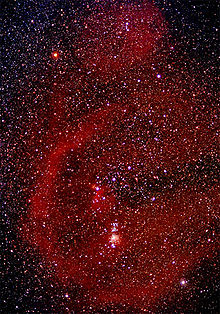Orion Molecular Cloud Complex
- Orion Molecular Cloud Complex
-

A picture of Barnard's Loop, which is a primary component of the nebula complex. Also seen in the image are the locations of other nebulae in the complex such as M42.
The Orion Molecular Cloud Complex (also often referred to as simply the Orion Complex) refers to a large group of bright nebula, dark clouds, and young stars located in the constellation of Orion. The cloud itself is between 1,500 and 1,600 light-years away and is hundreds of light-years across. Several parts of the nebula can be observed through binoculars and small telescopes, with some parts (such as the Orion Nebula) being visible to the naked eye.
The nebula is important because of the sheer size as it spreads several degrees from Orion's Belt to his sword. It is also one of the most active regions of stellar formation that can be seen in the night sky, and is home to both protoplanetary discs and very young stars. The nebula is also very bright in the infrared wavelengths due to the heat-intensive processes involved in the stellar formation, although the complex contains dark nebulae, emission nebula, reflection nebula, and HII regions.
Nebulae within the complex
The following is a list of notable nebulae within the larger nebula complex:
Also the Orion OB1 Association is part of this complex.
See also
External links
Categories:
- Astronomy stubs
- Orion complex
- Molecular clouds
Wikimedia Foundation.
2010.
Look at other dictionaries:
Molecular cloud — See also: Solar nebula Within a few million years the light from bright stars will have boiled away this molecular cloud of gas and dust. The cloud has broken off from the Carina Nebula. Newly formed stars are visible nearby, their images… … Wikipedia
Orion Nebula — The entire Orion Nebula in visible light. Credit: NASA/ESA Observation data: J2000 epoch … Wikipedia
Orion OB1 Association — The Orion OB1 stellar association is a contingent group of several dozen hot giant stars of spectral types O and B. Associated are thousands of lower mass stars, and a (smaller but significant) number of protostars. It is part of the larger Orion … Wikipedia
Orion (constellation) — For other uses, see Orion (disambiguation). Orion Constellation List of stars in Orion Abbreviation Ori Genitive Orionis … Wikipedia
Nuage d'Orion — Photo de la boucle de Barnard, qui est une composante primaire du complexe nébulaire. Sur l image sont visibles également d autres nébuleuses du complexe telles que M42. Le nuage moléculaire d Orion (appelé parfois également le complexe d Orion)… … Wikipédia en Français
Ammonia — For other uses, see Ammonia (disambiguation). Ammonia … Wikipedia
Nebula — Nebulae redirects here. For the supercomputer in China, see Nebulae (computer). For other uses, see Nebula (disambiguation). The Pillars of Creation from the Eagle Nebula … Wikipedia
Orders of magnitude (mass) — Iron weights up to 50 kilograms depicted in Dictionnaire encyclopédique de l épicerie et des industries annexes. To help compare different orders of magnitude, the following list describes various mass levels between 10−36 kg and 1060 kg … Wikipedia
Messier 78 — For other uses, see M78. M78 Image of the reflection nebula Messier 78 was captured using the Wide Field Imager camera on the MPG/ESO 2.2 metre telescope at the La Silla Observatory. Observation data: J2000.0 epoch … Wikipedia
Messier 43 — De Mairan s Nebula (M43) taken by the Wide Field Channel of Hubble’s Advanced Camera for Surveys. Observation data: J2000 epoch Type … Wikipedia

